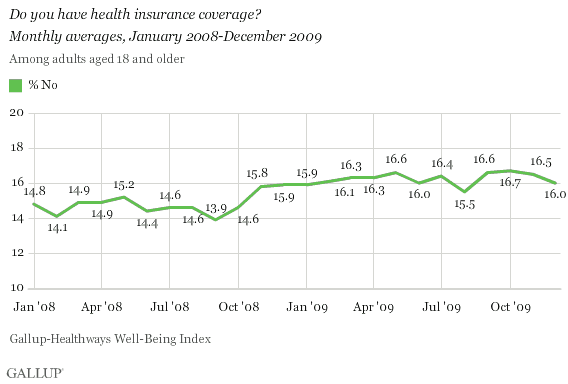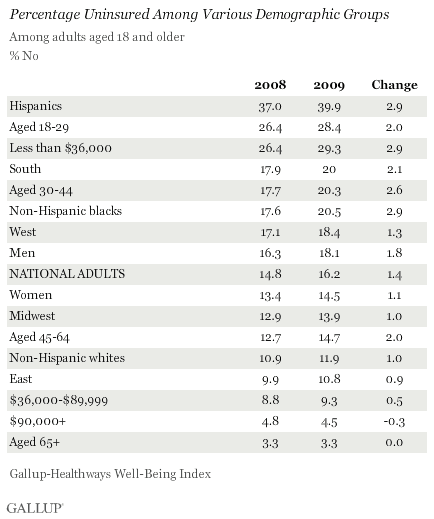WASHINGTON, D.C. -- While President Obama works with House and Senate leaders to hammer out a final healthcare bill before the State of the Union address, the legislation's goal of expanding coverage to the uninsured will need to cover a larger pool of Americans who are without health insurance. According to the ���۴�ýHealthways Well-Being Index, an average of 16.2% of American adults lacked health insurance coverage in 2009, up from 14.8% in 2008.

The number of , coincident with the worst of the economic crisis. With some month-to-month fluctuations, the number of uninsured Americans has remained elevated since that time. ���۴�ýand Healthways ask at least 1,000 Americans, aged 18 and older, each day if they have health insurance coverage. Each monthly average encompasses approximately 30,000 interviews. The yearly averages from 2008 and 2009 consist of approximately 350,000 interviews each.
Demographics of the Uninsured
Hispanics continue to be among the most likely demographic segment of the adult population to be uninsured, with 39.9% reporting in 2009 that they are without healthcare coverage, up from 37.0% in 2008, and more than double the current national average. Along with Hispanics, Americans aged 18 to 29 (28.4%) and those with yearly incomes of less than $36,000 (29.3%) rank among the segments of the population most likely to be uninsured, as they did in 2008. However, in 2009, the proportion of low-income Americans who are uninsured exceeded the proportion of those aged 18 to 29 who lack health insurance after both groups were equally likely to be uninsured in 2008.

Groups who are among the most likely to be uninsured also, for the most part, experienced the largest increases in percentage uninsured in 2009 compared with 2008. From 2008 to 2009, the percentage of uninsured low-income Americans, Hispanics, and blacks increased by 2.9 percentage points. Americans aged 65 and older and those with yearly incomes of $36,000 or greater experienced essentially no change in the percentage of uninsured in 2009 compared with 2008. There was a slight decrease in the already low percentage of those without health insurance among those with $90,000+ household incomes.
Bottom Line
Despite marginal fluctuation from month to month, the percentage of uninsured in the United States clearly rose in 2009 from 2008 levels. Given the large sample sizes from both years, the change of 1.4 points is significant. While Hispanics continued to be among the most likely to be uninsured in 2009, they, along with almost every other demographic group, saw an upswing in the percentage of those without health coverage last year compared with 2008. The elderly and those with higher incomes were the two groups immune to significant year-over-year increases.
Learn more about the .
Survey Methods
For the Gallup-Healthways Well-Being Index, ���۴�ýis interviewing no fewer than 1,000 U.S. adults nationwide each day. All monthly samples are near 30,000 per month. For monthly results based on the total sample of national adults, one can say with 95% confidence that the maximum margin of sampling error is ±0.6 percentage point.
Over 350,000 surveys were completed in each calendar year, yielding percentages with maximum expected error range of ±0.2%.
Interviews are conducted with respondents on landline telephones and cellular phones.
In addition to sampling error, question wording and practical difficulties in conducting surveys can introduce error or bias into the findings of public opinion polls.
About the Gallup-Healthways Well-Being Index™
The Gallup-Healthways Well-Being Index measures the daily pulse of U.S. wellbeing and provides best-in-class solutions for a healthier world. To learn more, please visit .
